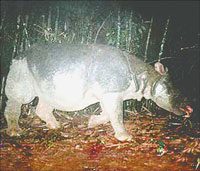Yesterday, July 1, was the anticipated deadline for the completion of the application for UNESCO to recognize Cat Tien National Park (CTNP) as a World Natural Heritage site. However, to date, the situation of encroachment on CTNP has not been effectively stopped or resolved.
 |
One-horned rhinoceros at CTNP |
The latest survey results from domestic and international scientists have identified a remarkable “collection” within CTNP, featuring 1,610 plant species (belonging to 724 genera and 162 families). This includes 176 species of large trees, 345 species of shrubs, and 238 species of vines, alongside nearly 1,490 animal species, including 103 rare species such as the Javan rhinoceros, wild cattle, freshwater crocodiles, red woodpeckers, white-necked cranes, and red junglefowl…
With such valuable figures, CTNP is recognized as the region with the richest biological resources in Vietnam. Its abundant plant and animal resources, combined with its landscape features, make CTNP an important “museum” for natural scientists.
However, the Cát Tiên “treasure” seems to have not received adequate attention for preservation and protection. In early June of this year, in a quick report sent to the leaders of the Ministry of Agriculture and Rural Development and the Chairman of the Lam Dong Provincial People’s Committee, Mr. Trần Văn Mùi, the Director of CTNP wrote: “The hotspot of deforestation is occurring in villages 3 and 4, Phước Cát 2 commune, Cát Tiên district, Lam Dong. The logging activities are organized, and the areas being cleared are located in the core zone of the national park. In sub-zones 499 and 500, a region of bamboo and reed has been cleared. Only the large tree trunks remain uncut…”
Mr. Lưu Văn Hào, the head of the CTNP Forest Protection Department, confirmed: “In May 2006 alone, in village 3 of Phước Cát 2 commune, the area of forest cleared reached 26.1271 hectares of bamboo and timber mixed forest, of which 20.1272 hectares were completely cleared and 6 hectares were under partial clearance (not yet felled) in village 4, Phước Cát 2 commune, where residents also cleared forest to open a road (1.5m wide and 3.5m long) running through the special-use forest…”
Experts from WWF Indochina also expressed concern. Mr. David Murphy stated: “Since 1999, after confirming the presence of the Javan rhinoceros, considered one of the rarest animals on Earth, CTNP has gained worldwide attention. Conservation projects for these rare rhinoceroses in Vietnam have been established, as this is one of only two remaining populations of rhinoceroses on the planet.
However, according to the latest report, after six years of project implementation, only seven rhinoceroses remain in CTNP. We have designated 5,000 hectares as a habitat for the rhinoceros, and this area is strictly protected. Yet in reality, the habitat and lives of the rhinoceroses are constantly threatened by landless immigrants, illegal logging, and poaching…”
This is the result of delays in the relocation project for residents living within the park’s boundaries.
The environmental concerns mentioned above need to be addressed promptly by the government and scientific organizations. The meeting of the National Heritage Council at CTNP on May 21 has agreed on the principle of preparing scientific documentation to soon present to UNESCO for the recognition of CTNP as a World Natural Heritage site, with cultural factors being a supplementary component.




















































